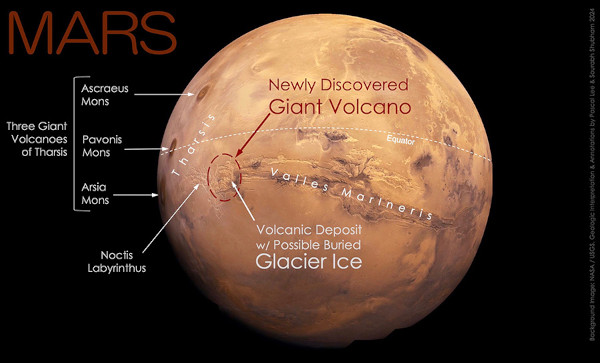Although the volcano itself is old, the discovery is new. By comparing images of several spacecraft, scientists found the huge shape.
The volcano, provisionally named “Noctis Mons,” has been imaged by several spacecraft since the early 1970s, but due to severe erosion in the area, it has not been easy to spot in images. In addition, traces of a glacier adjacent to the former crater were also found buried under the slope of the volcano.
Noctis Mons is located near the Martian equator, in the eastern part of the Tharsis volcanic mountain range, sandwiched between the Vallis Marineris system and the Noctis Labyrinthus cross-zone characterized by depressions and narrow valleys, namely the eastern part of the labyrinthine Noctis itself that forms the volcano. Pascal Li, a researcher at the SETI Institute and the Mars Institute, reported on the discovery at the 55th Lunar Research and Planetary Science Conference.
The recently discovered supervolcano is located south of the Martian equator, on the eastern edge of the Tharsis Mountain Range, sandwiched between the Noctis Labyrinthus system and the Mariner Valley system. The location of the new volcano, provisionally named Noctis Mons, is indicated by the red circle, and it can be seen that it has eroded much more than the larger shield volcanoes of Tharsis. (pictureBackground: NASA/USGS. Translated and translated by: Pascal Lee and Saurabh Shubham)
The diameter of the newly discovered volcano is about 450 kilometers, and despite being subjected to severe erosion, it is still 9 kilometers higher than the average surface of the planet in some places. It is therefore dwarfed by the largest volcano on Earth, Mauna Loa, which reaches a height of only 8 kilometers even from the sea floor, and its largest diameter is 120 kilometers. However, there are also larger volcanoes on Mars, chief among them the record holder Olympus Mons which is more than 22 km high.
Mariner 9 imaged the area as early as 1971, but the volcano has not been identified either in those images or in images taken by other probes since then, because the area does not look as it does today due to surface fragmentation, thermal erosion, and the erosive effect of ice. On the beautiful cone-shaped shield volcanoes located further away. Instead, Noctis Mons consists of raised plateaus of former lava, lava debris, and water ice separated by a network of valleys and collapsed areas. By piecing together the evidence, researchers were still able to reconstruct the volcanic origin of the area. Plateaus define a curved shape that slopes slightly away from the center. Remnants of the caldera can also be identified in the middle of the structure, and traces of lava flows, volcanic ash deposits, and wet mineral deposits have been found scattered in many places in the area. The individual details were known before, but combining them into a single piece of evidence of the former existence of a supervolcano surprised researchers. Some see other possible explanations for the creation of the area, but Lee considers the data supporting the giant volcano hypothesis convincing.
The newly discovered volcano was located at the center of the most violent geological processes on Mars. (picture: NASA Mars Global Surveyor / Mars Orbiter Laser Altimeter Digital Elevation Model; Translated and translated by: Pascal Lee and Saurabh Shubham)
During the investigation, volcanic deposits were found in a large area around Noctis Mons. These areas are characterized by rounded, bump-like hills, called “rootless cones.” They likely formed when hot volcanic material fell onto ice or a water-rich surface, causing violent steam explosions. This discovery is also linked to a previous discovery by researchers, during which they found sulphate deposits with the shape and characteristics of a glacier. According to Li and his colleague, these glacier-like shapes may have formed when volcanic ash fell onto the glacier. The ash reacted with acidic water, creating a mineral called jarosite. Its deposits followed the shape of the deeper glacier. Later, erosion removed the ash layer in some places, bringing layers of glacial salt to the surface. It is assumed that the ice still exists today, as the salt layer protects it from disappearing. It is also hypothesized that Noctis Mons may have had a layered structure containing alternating deposits of ice and volcanic material.
The Noctis Mons area provides plenty of geological evidence of the existence of the giant volcano. The hot material ejected during the explosions fell on the ice and caused steam to erupt, creating so-called “rootless cones.” In the cracks of volcanic sediments, deposits of sulfate salts appear, which were formed as a result of chemical reactions between volcanic rocks and ice. The largest sulphate deposits are shaped like a glacier, which may be the remains of an ancient glacier (an ancient glacier). The glacier may have been preserved beneath the surface so far under a thin layer of sulphate deposited on it. (picture: NASA's Mars Reconnaissance Orbiter / High-Resolution Imaging Science Experiment / Context Imager / Mars Compact Reconnaissance Imaging Spectrometer; Translated and translated by: Pascal Lee and Saurabh Shubham)
There are still many questions to be clarified in the case of Noctis Mons. Evidence suggests that the volcano may have been active in ancient Martian history, but the exact date remains to be determined, as well as whether the area is still active today. Meanwhile, the continuous presence of volcanic heat and groundwater over billions of years makes the region particularly interesting from the point of view of searching for life on Mars. However, from a geological point of view, the area is interesting because thanks to erosion, we can glimpse the internal structure of a giant Martian volcano.
Related articles:
Mars beyond violet
Distribution of ice on Mars
Mineralogical composition of Mars
The first real map of Mars is born: Mariner 9 flew 40 years ago (Part 2)
The most powerful valley on Mars through the eyes of Mars Express
Related links:
Ancient Volcano on Mars (Sky and Telescope)
Discovery of a giant volcano on Mars (SETI Institute)














































